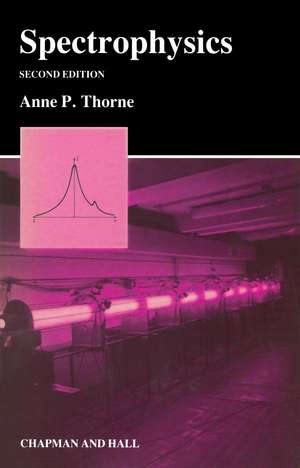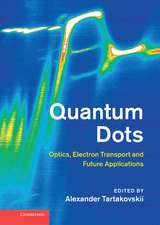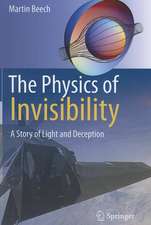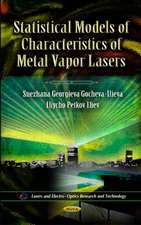Spectrophysics
Autor Anne P. Thorneen Limba Engleză Paperback – 16 iun 1988
Preț: 780.97 lei
Preț vechi: 952.40 lei
-18% Nou
Puncte Express: 1171
Preț estimativ în valută:
149.43€ • 156.44$ • 123.65£
149.43€ • 156.44$ • 123.65£
Carte tipărită la comandă
Livrare economică 07-21 aprilie
Preluare comenzi: 021 569.72.76
Specificații
ISBN-13: 9780412274701
ISBN-10: 0412274701
Pagini: 380
Ilustrații: 380 p.
Dimensiuni: 155 x 235 x 21 mm
Greutate: 0.57 kg
Ediția:Softcover reprint of the original 1st ed. 1988
Editura: SPRINGER NETHERLANDS
Colecția Springer
Locul publicării:Dordrecht, Netherlands
ISBN-10: 0412274701
Pagini: 380
Ilustrații: 380 p.
Dimensiuni: 155 x 235 x 21 mm
Greutate: 0.57 kg
Ediția:Softcover reprint of the original 1st ed. 1988
Editura: SPRINGER NETHERLANDS
Colecția Springer
Locul publicării:Dordrecht, Netherlands
Public țintă
ResearchCuprins
1 Introduction.- 1.1 The uses of spectroscopy.- 1.2 Scope of this book.- 1.3 The electromagnetic spectrum.- 1.4 Term diagrams and line series.- 1.5 Sources, detectors and dispersers.- 1.6 Survey of spectral regions.- 1.7 Wavelength standards.- 1.8 Units used in this book.- References.- 2 A Summary of atomic structure.- 2.1 Schrödinger’s equation: wave functions.- 2.2 The hydrogen atom: degeneracy and spin.- 2.3 The Pauli exclusion principle and shell structure.- 2.4 The central field model.- 2.5 Interlude: perturbation theory.- 2.6 Electrostatic interactions: the quantum numbers L and S.- 2.7 Magnetic interactions: the quantum numbers j and J.- 2.8 Radiative transitions and selection rules.- 2.9 Zeeman and Stark effects.- 2.10 Configuration interaction and auto-ionization.- 2.11 Hyperfine structure and isotope shift.- 2.12 Ionic spectra.- 2.13 Inner shell and X-ray spectra.- References.- 3 A summary of molecular structure.- 3.1 Interatomic potentials.- 3.2 The Born-Oppenheimer approximation.- 3.3 Electronic energy of diatomic molecules.- 3.4 Vibrational energy of diatomic molecules.- 3.5 Rotational energy of diatomic molecules.- 3.6 Spectra of diatomic molecules.- 3.7 Transition probabilities for diatomic molecules.- 3.8 Some further points on spectra of diatomic molecules.- 3.9 Remarks on polyatomic molecules.- References.- 4 Light sources and detectors.- 4.1 Definitions of light flux.- 4.2 Blackbody radiation and sources of continuum.- 4.3 Intensity standards.- 4.4 The excitation of line spectra.- 4.5 The Einstein probability coefficients.- 4.6 The different types of light source.- 4.7 Traditional sources: flames, arcs, sparks and glow discharges.- 4.8 Special sources.- 4.9 Absorption spectroscopy.- 4.10 General remarks on detectors.- 4.11 Detectors for theinfra-red.- 4.12 Detectors for the visible and ultra-violet.- 4.13 Photographic emulsions.- 4.14 Array detectors.- References.- 5 Dispersion and resolving power: prism spectrographs.- 5.1 General remarks.- 5.2 Dispersion and resolving power.- 5.3 Slit width.- 5.4 Throughput and illumination.- 5.5 Prism instruments.- 5.6 Deviation and dispersion.- 5.7 Resolving power.- 5.8 Prism materials.- 5.9 Image defects.- 5.10 Merits of prism spectrometers.- References.- 6 Diffraction gratings.- 6.1 Plane grating: condition for maxima.- 6.2 Intensity distribution from ideal diffraction grating.- 6.3 Dispersion and resolving power.- 6.4 Concave gratings.- 6.5 Grating mountings.- 6.6 Production and characteristics of gratings.- 6.7 Gratings for special purposes.- References.- 7 Interferometers.- 7.1 Some basic concepts of interferometric spectroscopy.- 7.2 Resolution and throughput.- 7.3 Fabry-Perot interferometers: intensity distribution.- 7.4 Fabry-Perot interferometers: resolution and limitations.- 7.5 Fabry-Perot interferometers: methods of use.- 7.6 Michelson interferometers and Fourier transform spectroscopy.- 7.7 Fourier transform spectroscopy: instrument function, resolution, sampling and aliasing.- 7.8 Fourier transform spectroscopy: computing and control.- 7.9 Fourier transform versus grating spectroscopy: a comparison.- References.- 8 Laser spectroscopy.- 8.1 Introduction to lasers.- 8.2 Types of laser.- 8.3 Optical pumping and saturation.- 8.4 Spectral and temporal resolution.- 8.5 Laser absorption and excitation experiments.- 8.6 Doppler-free spectroscopy.- 8.7 High intensity effects, cooling and trapping.- References.- 9 Other spectroscopic methods: microwave, radiofrequency, level-crossing and Raman.- 9.1 Introduction.- 9.2 Microwave spectroscopy.- 9.3 Microwave spectroscopy of gases: the principal applications.- 9.4 Magnetic resonance spectroscopy: general considerations.- 9.5 Electron spin and nuclear magnetic resonance spectroscopy (ESR and NMR).- 9.6 Atomic and molecular beam magnetic resonance.- 9.7 Transitions in and information from beam magnetic resonance.- 9.8 Double resonance and optical pumping experiments.- 9.9 Level-crossing experiments.- 9.10 Raman spectroscopy.- 9.11 Coherent anti-Stokes Raman spectroscopy (CARS).- References.- 10 Width and shape of spectral lines.- 10.1 Line profiles.- 10.2 Natural broadening.- 10.3 Doppler broadening.- 10.4 Introduction to pressure broadening.- 10.5 Pressure broadening: types of perturbation.- 10.6 Pressure broadening: the impact approximation.- 10.7 Pressure broadening: the quasi-static approximation.- 10.8 Experimental aspects of pressure broadening.- 10.9 Convolution of line profiles: the Voigt profile.- References.- 11 Emission and absorption of line radiation.- 11.1 Introduction.- 11.2 Boltzmann distribution of population and state sum.- 11.3 Einstein coefficients and line strength.- 11.4 Absorption coefficient.- 11.5 Oscillator strength.- 11.6 The f-sum rule.- 11.7 Optical depth and equivalent width.- 11.8 Curve of growth.- 11.9 Emission lines; source function and radiative transfer.- 11.10 f-values in diatomic molecules.- References.- 12 Experimental determination of transition probabilities and radiative lifetimes.- 12.1 Introduction.- 12.2 Remarks on the calculation of transition probabilities.- 12.3 Emission measurements.- 12.4 Absorption and dispersion measurements.- 12.5 Lifetime measurements.- 12.6 Combinations of methods.- References.- 13 Elementary plasma spectroscopy.- 13.1 Introduction.- 13.2 Debye radius.- 13.3 Plasma oscillations.- 13.4 Energy distribution and dissociation equilibrium.- 13.5 Saha’s equation for ionization equilibrium.- 13.6 Depression of ionization potential and Inglis-Teller limit.- 13.7 Electron collisional rates.- 13.8 Local thermodynamic equilibrium.- 13.9 Coronal equilibrium and ionization equilibrium.- 13.10 Continuous emission and absorption.- 13.11 The continuous absorption cross-section.- 13.12 The continuous emission.- 13.13 Other continua.- 13.14 Applications of plasma spectroscopy.- 13.15 Spectroscopic measurement of temperature.- 13.16 Spectroscopic determination of electron density.- References.

















